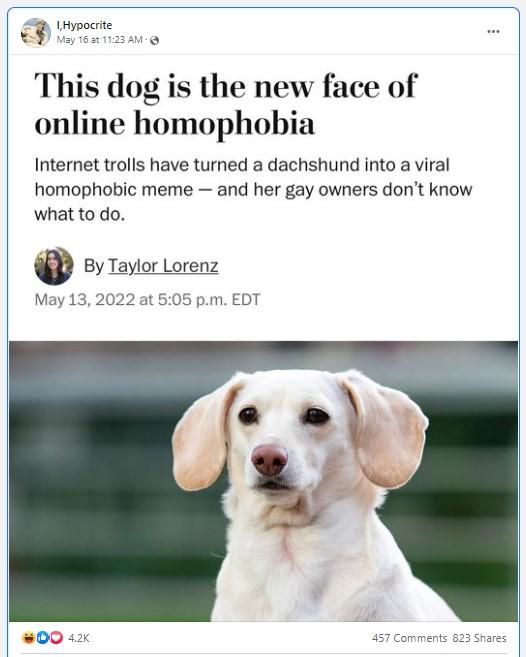Let's talk about something that might sound bizarre but is definitely sparking conversations worldwide – the so-called "homophobic dog." Now, before you roll your eyes thinking this is just another internet sensation, hear me out. This isn't just a quirky story; it's a fascinating look into animal behavior, human perception, and the way we interpret the world around us. So, buckle up, because we're diving deep into this unexpected phenomenon.
Imagine this – you're scrolling through social media, minding your own business, when suddenly you come across a viral post about a dog that apparently "hates" other dogs of the same gender. Sounds ridiculous, right? Well, it's not as far-fetched as you might think. This story has sparked debates, memes, and even some serious discussions about whether animals can exhibit what we humans perceive as "homophobia."
Now, before we go any further, let's get one thing straight – the term "homophobic dog" is more of a human interpretation than a scientific fact. But that's what makes it so intriguing. It's not just about the dog; it's about how we project our own biases and understanding onto the animal kingdom. So, let's break it down and see what's really going on here.
Read also:Mary Holland The Rising Star Whos Making Waves In The Industry
What Exactly Is a Homophobic Dog?
When we talk about a "homophobic dog," we're referring to a behavior observed in certain canines where they seem to dislike or avoid interacting with dogs of the same gender. Now, before you start thinking about complex social issues, let's remember that animals don't have the same cultural or societal constructs as humans. What we perceive as "homophobia" might actually be something entirely different.
Some experts suggest that this behavior could be linked to territorial instincts, dominance hierarchies, or even past experiences. Others argue that it might simply be a coincidence or a misinterpretation of normal dog behavior. Either way, it's a topic that has sparked a lot of interest and debate.
Understanding Dog Behavior
To really understand what's going on with these so-called "homophobic dogs," we need to take a closer look at how dogs interact with each other. Dogs are social animals, and their behavior is often influenced by a variety of factors, including genetics, environment, and past experiences.
Here are a few things to consider:
- Genetics: Some dogs may naturally be more aggressive or territorial towards others of the same gender.
- Environment: A dog's upbringing and socialization can play a big role in how they interact with other dogs.
- Past Experiences: If a dog has had negative interactions with dogs of the same gender in the past, they might develop a preference for the opposite gender.
Can Animals Be Homophobic?
This is where things get really interesting. Can animals, specifically dogs, exhibit behaviors that we would classify as "homophobic"? The short answer is no – at least not in the way humans understand the term. Animals don't have the same societal constructs or moral judgments as humans. What we perceive as "homophobia" might actually be something entirely different.
Some researchers suggest that what we're seeing in these dogs might be more about competition for resources or mates rather than any kind of prejudice. Others argue that it could be a result of learned behavior – dogs picking up on cues from their human companions.
Read also:Lee Yikyung The Rising Star Redefining Kdrama Landscape
Human Projection in Animal Behavior
One of the most fascinating aspects of this phenomenon is how humans interpret animal behavior. We tend to project our own biases and understanding onto the animal kingdom, often without realizing it. This can lead to some interesting – and sometimes misleading – conclusions.
For example, when we see a dog avoiding other dogs of the same gender, we might jump to the conclusion that they're "homophobic." But in reality, there could be a whole host of other reasons for this behavior. It's important to approach these situations with an open mind and a willingness to learn.
Scientific Studies on Dog Behavior
While there hasn't been a specific study on so-called "homophobic dogs," there have been plenty of studies on dog behavior in general. These studies can help us better understand why dogs might exhibit certain behaviors and what it might mean.
One study conducted by the University of California found that dogs are capable of forming complex social hierarchies and that these hierarchies can influence their interactions with other dogs. Another study by the University of Bristol looked at how dogs interpret social cues from humans and other dogs, suggesting that they are highly attuned to the world around them.
Key Findings from the Studies
Here are a few key takeaways from these studies:
- Dogs are capable of forming complex social relationships with other dogs and humans.
- They are highly attuned to social cues and can pick up on subtle changes in behavior.
- Past experiences and environment play a significant role in shaping a dog's behavior.
How to Handle a "Homophobic Dog"
If you're a dog owner and you suspect that your furry friend might be exhibiting this behavior, there are a few things you can do to help. First and foremost, it's important to understand that this behavior is not necessarily "homophobia" in the human sense. It's more likely a result of other factors, such as territorial instincts or past experiences.
Here are a few tips:
- Socialization: Make sure your dog has plenty of opportunities to interact with other dogs in a positive environment.
- Training: Work with a professional trainer to address any behavioral issues.
- Patience: Remember that behavior change takes time and patience.
When to Seek Professional Help
If your dog's behavior is causing problems or putting them or other dogs at risk, it might be time to seek professional help. A certified dog trainer or behaviorist can help you identify the root cause of the behavior and develop a plan to address it.
Real-Life Examples of "Homophobic Dogs"
There are plenty of stories out there about dogs that seem to dislike other dogs of the same gender. One of the most famous examples is a dog named Max, who gained internet fame for his apparent "disdain" for male dogs. Max's owner reported that he would bark and growl at male dogs but was perfectly friendly with female dogs.
Another example is a dog named Bella, who reportedly avoided other female dogs at the park. Her owner speculated that it might have something to do with a past experience, but the exact cause remains a mystery.
What Can We Learn from These Stories?
While these stories might seem like just another internet sensation, they offer valuable insights into dog behavior and human perception. They remind us that animals are complex creatures with their own unique personalities and behaviors. And they challenge us to look beyond our own biases and try to understand the world from their perspective.
The Importance of Empathy in Understanding Animals
At the end of the day, the story of the "homophobic dog" is less about the dog itself and more about how we interpret and understand the animal kingdom. It's a reminder that animals are complex creatures with their own unique needs and behaviors. And it's a call to action for us to approach them with empathy and understanding.
So, the next time you come across a story about a "homophobic dog," take a moment to think about what's really going on. Is it really about homophobia, or is it something else entirely? Whatever the answer, it's a fascinating glimpse into the world of animal behavior and human perception.
How You Can Make a Difference
Here are a few ways you can make a difference:
- Stay informed about animal behavior and welfare.
- Approach animals with empathy and understanding.
- Share your knowledge with others to help promote a better understanding of the animal kingdom.
Conclusion: The Bigger Picture
In conclusion, the story of the "homophobic dog" is more than just a quirky internet sensation. It's a fascinating look into animal behavior, human perception, and the way we interpret the world around us. While the term "homophobic dog" might be a bit of a misnomer, it's a reminder that animals are complex creatures with their own unique needs and behaviors.
So, what can we take away from all of this? First and foremost, it's important to approach animals with empathy and understanding. It's also important to stay informed about animal behavior and welfare, and to share our knowledge with others. And finally, it's a reminder that the world is full of fascinating stories just waiting to be discovered.
So, the next time you come across a story about a "homophobic dog," take a moment to think about what's really going on. You might just learn something new about the animal kingdom – and about yourself in the process.
Now, it's your turn. What do you think about the "homophobic dog" phenomenon? Leave a comment below and let's continue the conversation. And don't forget to share this article with your friends and family – the more we talk about these issues, the more we can learn and grow together.
Table of Contents


